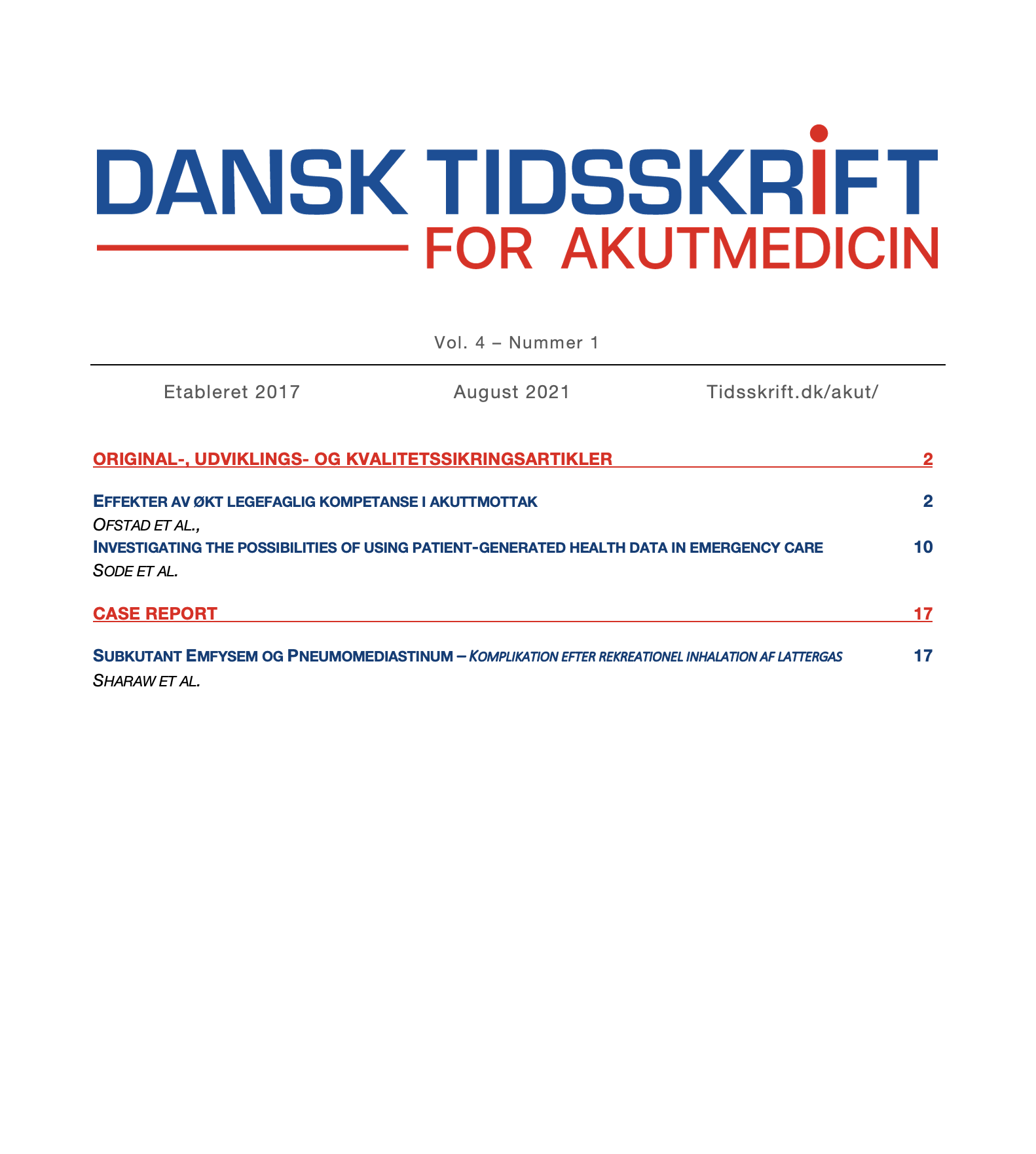Abstract
Abstract
It is well known that emergency departments (EDs) are exposed to human errors and unintended events due to large patient flow, high work pressure and overload of information. Strategies for providing efficient and effective health care are therefore imperative, and health information technologies are suggested to be one of the solutions. This study sought to investigate if the use of patient-generated health data gathered through a digital patient questionnaire and visualised as a patient-generated journal (PGJ v.1.0) has the potential to improve the care delivered in EDs.
Methods
Using a mixed-method approach, the PGJ (v.1.0) was investigatedfrom key stakeholders’ perspectives. First, we examined the PGJ from a patient perspective via participant observation (n = 18) and interviews (n = 18), supported by statistical data from the PGJ (n = 56). Second, we used questionnaires to explore the physicians’ perspectives (n = 9). Lastly, two interviews were conducted with healthcare leaders from the ED. The data were compared and analysed using descriptive statistics and hermeneutic analysis.
Results
From the findings, it appears that patients in need of urgent care accept the use of patient-generated data, and patients highly favoured being active in their patient pathway. However, the system needed some adjustments to fit the patients’abilities in urgent situations.The physicians expressed mixed attitudes towards the PGJ: the majority agreed that the system needed some adjustments in order for the full benefits to be gained, but thought that it had potential to improve their work processes when fully developed.
Conclusions
This study concludes that the use of patient-generated data is well accepted by patients in an urgent setting, and that the PGJ has the potential to improve quality of care in patient pathways by adding value to patient flows as well as clinical workflows. The concept of utilising patient-generated health data in emergency care should therefore be further developed and investigated.
References
References
Swancutt D, Joel-Edgar S, Allen M, Thomas D, Brant H, Benger J, et al. Not all waits are equal: an exploratory investigation of emergency care patient pathways. BMC Health Serv Res. 2017;17(1): 436. https://doi.org/10.1186/s12913-017-2349-2
Danske Regioner, Sundhedsstyrelsen og Sundheds- og Ældreministeriet. DE DANSKE AKUTMODTAGELSER - STATUS 2016 [Internet]. 2016. Available from: https://sum.dk/Aktuelt/Publikationer/De-dansk-akutmodtagelser-maj-2016.aspx [Access date 1 Feb 2020]
Benaroia M, Elinson R, Zarnke K. Patient-directed intelligent and interactive computer medical history-gathering systems: a utility and feasibility study in the emergency department. Int J Med Inform. 2007;76(4):283–8. https://doi.org/10.1016/j.ijmedinf.2006.01.006
Bachman JW. The patient-computer interview: a neglected tool that can aid the clinician. Mayo Clin Proc. 2003;78(1):67–78. https://doi.org/http://dx.doi.org/10.4065/78.1.67
Bachman J. Improving care with an automated patient history. Fam Pract Manag. [Internet]. 2007;14(7):39–43. Available from: https://www.ncbi.nlm.nih.gov/pubmed/17696057 [Access date 5 Jan 2020]
Slack WV, Kowaloff HB, Davis RB, Delbanco T, Locke SE, Bleich HL. Test–retest reliability in a computer-based medical history. J Am Med Inform Assoc. 2011;18(1):73–6. https://doi.org/10.1136/jamia.2010.005983
Slack WV, Kowaloff HB, Davis RB, Delbanco T, Locke SE, Safran C, et al. Evaluation of computer-based medical histories taken by patients at home. J Am Med Inform Assoc. 2012;19(4):545–8. https://doi.org/10.1136/amiajnl-2011-000580
Herrick DB, Lehmann HP, Nakhasi A, Abbott PA, Tehrani ASS, Newman-Toker DE, et al. Usability characteristics of self-administered computer-assisted interviewing in the emergency department. Appl Clin Inform. 2013;04(02):276–92. https://doi.org/10.4338/ACI-2012-09-RA-0034
Moore BJ, Gaehde S, Curtic C. Architectural choices and challenges of integrating electronic patient questionnaires into the electronic medical record to support patient-centered care. AMIA Annu Symp Proc. [Internet]. 2008;2008:490–4. Available from: https://www.ncbi.nlm.nih.gov/pmc/articles/PMC2655980/ [Access date 5 Jan 2020]
Licensed under a Creative Commons Attribution 4.0 International License (CC BY 4.0).
© The Author(s).

